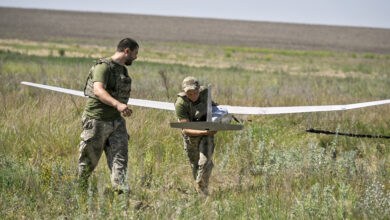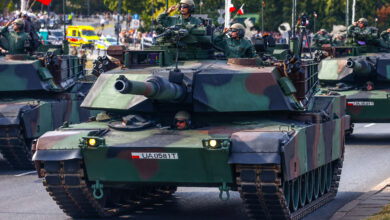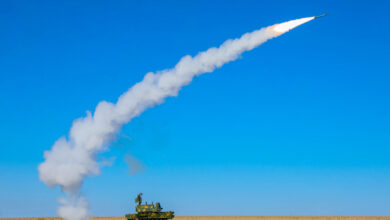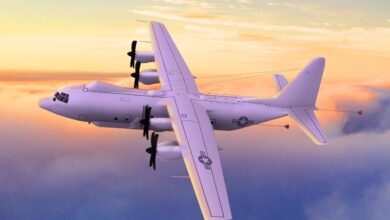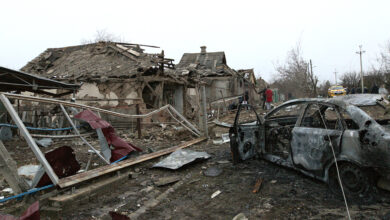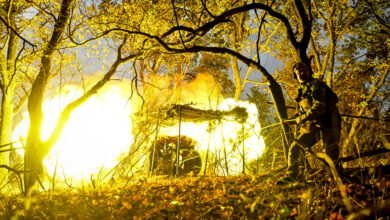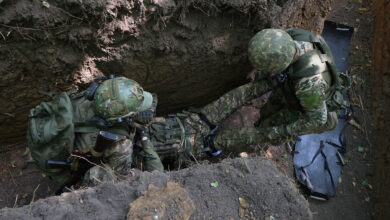Russia’s continuing efforts toward developing a long-range precision strike capability as part of a conventional strategic deterrent were highlighted in a March 24 speech by the Chief of the General Staff, General Valery Gerasimov. The development of such a capability has been an important aspect of Russian military modernization efforts for more than a decade.
In 2003, for example, the importance of a long-range precision strike capability was emphasixed in The Priority Tasks of the Development of the Armed Forces of the Russian Federation. This report, distributed at a conference held in Moscow in October 2003 under the auspices of President Vladimir Putin and the Ministry of Defence, placed much greater emphasis on aerospace and maritime forces conducting long-range precision strike operations, targeting an adversary’s critical infrastructure and significantly, and information warfare (whilst recognising the key role of the ground forces in ultimately securing victory).
The importance of long-range strike operations, targeting an adversary’s economic and critical infrastructure, and information warfare were highlighted in Gerasimov’s speech, in which he also emphasized the growing role and importance of advanced technologies, including robotics and unmanned systems. Gerasimov particularly noted Russian efforts to develop an ‘automated reconnaissance-strike system’ to significantly reduce the time required to find, fix and target an adversary, the increasing importance of space and information in warfare, and the potential for precision – including hypersonic – strike systems to contribute to strategic deterrence.
Russia’s strategic inventory
The Russian Armed Forces currently possess a limited conventional strategic precision strike capability, centered on the Russian Air Force’s Long Range Aviation Command’s Tupolev Tu-95MS Bear and Tu-160 Blackjack strategic bombers, and a growing number of ships and submarines of the Russian Navy armed with the Kalibr long-range (2,500 km) cruise missile.
The Russian Air Force operates around strategic bombers consisting of 60 Tupolev Tu-95MS/MSM Bear and 16 Tu-160 Blackjack (numbers are taken from the International Institute for Strategic Studies’ The Military Balance 2018), which can be armed in a precision-strike role with the 4,500 km-range Kh-101 cruise missile (operationally used in Syria).
Russia is developing a comprehensively upgraded Blackjack variant, the Tu-160M2, which is intended to enter production in 2023; at least 50 new bombers are currently planned to be built during the 2020s.

The Russian Air Force also operates around 60 Tu-22M3 Backfire long-range bombers, which along with the Bear and Blackjack will be equipped with the new 1,500 km-range Kh-50 cruise missile; the Backfire may also be capable of delivering the Kh-101. The Kh-50 and Kh-101 both incorporate low observable technologies.
An interim conventional air-launched cruise missile, the Kh-555, derived from the Kh-55, is in service with the Bear and Blackjack. The Kh-50 may also be integrated with the Sukhoi Su-34 Fullback tactical strike aircraft.
Significantly, in his March 1 speech, Putin disclosed that an air-launched 2,000 km-range hypersonic missile – Kinzhal – had entered service with the Russian Air Force in December 2017. The Kinzhal, likely to be an air-launched variant of the Iskander-M tactical ballistic missile, has been integrated with the MiG-31 interceptor and is capable of delivering a nuclear or conventional warhead. Development of a new strategic bomber – PAK DA – is underway and currently projected to enter service in the late 2020s.
Russian Navy plans
The development of a conventional long-range strike capability is a central element of the Russian Navy’s long-term modernization plans and is in part intended to address the current limited ability of the Navy to conduct conventional land-attack operations.
This will be centered on the submarine force, in particular the nuclear-powered Yasen and modernized Oscar II and the diesel-electric Improved Kilo classes, and surface ships such as the modernized Admiral Nakhimov (due to re-enter service in the early 2020s) and Pyotr Velikiy (Peter the Great), and Admiral Gorshkov-class frigates, six of which are due to enter service between 2018 and 2025. The first of the Yasen-class, Severodvinsk, entered service in 2013, with a further six upgraded boats due by the early 2020s.

The Russian Navy currently operates eight Oscar II-class submarines of which at least four will be upgraded and equipped with the Kalibr; six Improved Kilo-class boats have entered service with the Black Sea Fleet, with a further six boats due to enter service with the Pacific Fleet by 2022.
The Kalibr long-range cruise missile is central to Russian naval plans for a conventional strategic deterrent force, and notably is being deployed across a wide variety of surface combatants, including corvettes and light frigates. Moreover, the Tsirkon, a hypersonic cruise missile currently under development and due to enter operational service by the early 2020s, will be compatible with the launching system utilized by existing weapons such as the Oniks anti-ship missile and the Kalibr, and equip a wide range of Russian ships and submarines.
The development of advanced conventional long-range precision strike systems such as the Kh-50, Kh-101, Kinzhal and Kalibr, and the growing number of platforms capable of delivering such weapons, will provide Russia with a highly potent capability. Gerasimov stated in his March 24 speech that “in each strategic direction, groupings of long-range air and sea-based cruise missile delivery platforms capable of deterrence in strategically important areas have been established.”
The Russian Navy’s Northern, Baltic and Black Sea Fleets, plus the Caspian Flotilla, already operate ships and/or submarines armed with the Kalibr, whilst the Pacific Fleet may receive its first Kalibr-armed vessels by the end of 2018.

A growing capability
Together with the Air Force’s Bear and Blackjack strategic bombers, Russia can deliver cruise missile strikes against targets globally, a capability which will grow significantly over the coming decade as new ships, submarines and aircraft enter service. Further, the Avangard hypersonic glide vehicle, revealed by Putin in his March 1 speech, may also be capable of delivering a conventional warhead.
Although Russia has stated it is seeking to develop a conventional strategic deterrent, thus reducing its reliance on nuclear weapons, the potential for Moscow to utilize a conventional strategic strike capability as an instrument of coercion cannot be ignored. Russia has demonstrated, particularly since 2014, a willingness to use force, and its investment in long-range strike systems will provide it with a potent means of reinforcing its increasingly assertive national policy and desire for Great Power status.
The challenge for the West will be ensuring that Russia is deterred from using its conventional strategic strike, as well as its wider military capabilities to undermine international order and shift the global balance of power.
 Dr. James Bosbotinis is a U.K.-based specialist in defense and international affairs. He has written widely on issues including the development of U.K. maritime airpower, Russian maritime doctrine, naval and wider military (including nuclear) modernization, and China’s evolving strategy. Bosbotinis is also a Director of, and Head of Global Strategy at Citadel Missile Systems Inc., a U.S.-based company operating in the missile defense industry, and an Associate Member of the Corbett Centre for Maritime Policy Studies, King’s College London.
Dr. James Bosbotinis is a U.K.-based specialist in defense and international affairs. He has written widely on issues including the development of U.K. maritime airpower, Russian maritime doctrine, naval and wider military (including nuclear) modernization, and China’s evolving strategy. Bosbotinis is also a Director of, and Head of Global Strategy at Citadel Missile Systems Inc., a U.S.-based company operating in the missile defense industry, and an Associate Member of the Corbett Centre for Maritime Policy Studies, King’s College London.
Follow him on Twitter @JamesBosbotinis
All views and opinions expressed in this article are those of the author, and do not necessarily reflect the opinions or positions of The Defense Post.
The Defense Post aims to publish a wide range of high-quality opinion and analysis from a diverse array of people – do you want to send us yours? Click here to submit an Op-Ed.



